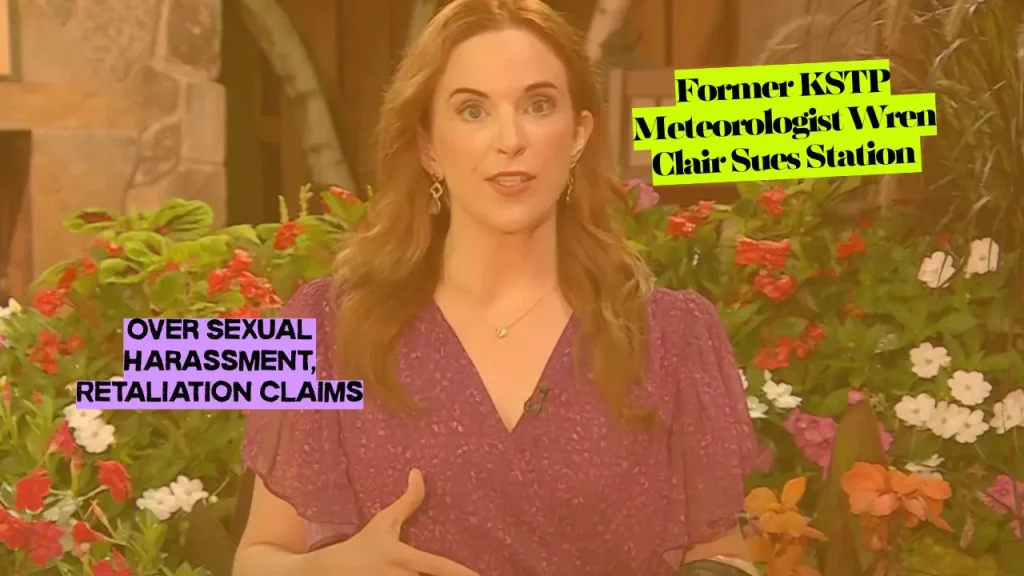Former KSTP Meteorologist Wren Clair Sues Station Over Sexual Harassment, Retaliation Claims
The Wren Clair lawsuit has become a significant legal case in the broadcasting industry, involving serious allegations of sexual harassment and retaliation against KSTP-TV, a prominent Minnesota television station. This high-profile case raises important questions about workplace harassment in the media industry and the rights of employees who report misconduct.
Wren Clair, formerly a KSTP-TV meteorologist, filed a sexual harassment and retaliation lawsuit against KSTP on Tuesday, Aug. 12, 2025, after being terminated in February 2025 following nearly seven years at the station.
For individuals following workplace harassment cases, broadcasting industry professionals, and those interested in employment law developments, understanding the Wren Clair lawsuit provides crucial insights into modern workplace protection laws and the legal remedies available to harassment victims.
Table of Contents
Who Is Wren Clair and What Is Her Lawsuit About?
Renee Fox, who uses the name Wren Clair in her profession as a meteorologist, has filed suit against KSTP, a local television broadcast station, alleging sexual harassment and retaliation while working as a meteorologist for KSTP.
Clair abruptly left the station in February after nearly seven years and joined KARE 11 in May. She is now working as a meteorologist for KARE-TV, but her legal battle with her former employer continues to unfold in Minnesota courts.
Background of Wren Clair’s Career
Professional Experience: Wren Clair worked as a meteorologist at KSTP-TV from 2018 to February 2025, building a nearly seven-year career at the St. Paul-based television station.
Current Position: Since May 2025, she has been working as a meteorologist for KARE 11, a competing Minneapolis-St. Paul television station.
Legal Representation: Halunen Law employment attorney, Paul Schinner, is representing Clair in this case.
Core Allegations in the Wren Clair Lawsuit
The Wren Clair lawsuit contains several serious allegations that paint a picture of a hostile work environment and systematic harassment at KSTP-TV.
Sexual Harassment Claims
Her lawsuit said she was demoted in 2024 and terminated in February, “but the sex-based disparate treatment and sexual harassment occurred throughout the entirety of her employment,” which began in 2018.
Appearance-Based Harassment: Wren Clair alleges that KSTP news director Kirk Varner repeatedly commented on her physical appearance, said she should wear tighter fitting clothes and complained about a change in her hair color.
Hostile Work Environment: Current KARE 11 meteorologist Wren Clair alleges that St. Paul-based news station KSTP-TV fired her earlier this year due to her repeated reports of sexual harassment and discrimination by male colleagues, including Dave Dahl and Kirk Varner.
Retaliation Claims
The lawsuit alleges that KSTP-TV retaliated against Clair after she reported the harassment to Human Resources.
“For years, Ms. Fox put up with sexist double standards and offensive conduct at KSTP,” according to Clair’s attorney, Paul Schinner. “When she finally reported it to Human Resources, she was quickly demoted and then abruptly fired.”
Timeline of Retaliation:
- Demotion in October 2024
- Vacation days docked without permission
- Termination on February 12, 2025, allegedly for “unsatisfactory performance”
Relaetd lawsuit: Shein Class Action Lawsuits Exposed – Get Up to $1,500 Per Text + $700K Settlement

Workplace Culture Allegations
The lawsuit claims Dave Dahl and others at KSTP fostered a sexist culture and engaged in lewd behavior. These allegations suggest systematic problems beyond individual incidents of harassment.
Discriminatory Treatment: The complaint alleges that Clair faced different standards and treatment compared to her male colleagues throughout her employment.
Management Complicity: The lawsuit suggests that management at KSTP either participated in or failed to address the alleged harassment effectively.
KSTP’s Response and Legal Defense
KSTP-TV has vigorously denied the allegations in the Wren Clair lawsuit and provided their own account of the employment termination.
Official Station Response
KSTP, in a legal response filed Wednesday in Ramsey County District Court, said Clair was terminated “as a result of her poor performance, on which she was repeatedly coached.” The response also said she was not “subjected to sex-based harassment.”
Performance-Based Termination: Wren Clair, whose legal name is Renee Fox, was fired from KSTP in February over poor performance; she alleges the dismissal was retaliatory in nature.
Denial of Harassment: The station categorically denies that Clair was subjected to any form of sex-based harassment during her employment.
Contradictory Evidence Claims
The complaint calls that reason “pretextual,” citing positive reviews, strong ratings, and the fact that a less qualified male replaced her with a history of performance issues.
No Formal Discipline: KSTP says that it fired Clair for poor performance and admits that she never received any formal disciplinary action.
This admission raises questions about the station’s performance-based termination claims, as employers typically document performance issues through formal disciplinary processes before termination.
Legal Framework and Claims in the Wren Clair Lawsuit
The Wren Clair lawsuit is filed under both federal and state employment laws that protect workers from harassment and retaliation.
Federal Legal Claims
Title VII of the Civil Rights Act: This federal law prohibits workplace discrimination and harassment based on sex, including sexual harassment and retaliation for reporting such conduct.
Equal Employment Opportunity Commission (EEOC): Before filing in court, Clair likely had to file an EEOC complaint, which is required for most federal employment discrimination claims.
Minnesota State Law Claims
Minnesota Human Rights Act: This state law provides additional protections against workplace harassment and may offer broader remedies than federal law.
Wrongful Termination: Minnesota law protects employees from termination in retaliation for reporting harassment or discrimination.
Potential Legal Remedies
If successful, the Wren Clair lawsuit could result in several forms of relief:
Monetary Damages: Compensation for lost wages, benefits, and emotional distress caused by the harassment and termination.
Punitive Damages: Additional compensation designed to punish the employer and deter future misconduct.
Injunctive Relief: Court orders requiring KSTP to change policies, provide training, or take other corrective actions.
Reinstatement: Although unlikely given Clair’s new position, courts can sometimes order reinstatement to previous employment.

Timeline of Events in the Wren Clair Case
Understanding the chronology of events helps clarify how the situation developed and the legal claims involved.
Employment Period (2018-2025)
2018: Wren Clair begins employment as a meteorologist at KSTP-TV.
2018-2024: Alleged harassment and discriminatory treatment occur throughout this period, according to the lawsuit.
2024: Clair is demoted from her position, allegedly in retaliation for reporting harassment.
Termination and Legal Action (2025)
February 12, 2025: KSTP terminates Clair’s employment, citing “unsatisfactory performance.”
May 2025: Clair joins KARE 11 as a meteorologist.
August 12, 2025: Wren Clair files her sexual harassment and retaliation lawsuit against KSTP.
August 13, 2025: KSTP files its legal response denying the allegations.
Broadcasting Industry Context and Similar Cases
The Wren Clair lawsuit occurs within a broader context of harassment allegations in the television news industry.
Industry-Wide Issues
The television news industry has faced numerous high-profile harassment cases in recent years, highlighting systemic problems with workplace culture and power dynamics.
Appearance-Based Discrimination: Female broadcasters frequently face scrutiny about their appearance that their male colleagues don’t experience.
Power Imbalances: The hierarchical structure of news organizations can create situations where harassment is more likely to occur and less likely to be reported.
Legal Precedents
Similar cases have established important legal principles:
Retaliation Protection: Courts have consistently held that firing employees for reporting harassment violates federal and state employment laws.
Hostile Work Environment: Employers can be held liable for harassment by supervisors and colleagues if they fail to take appropriate corrective action.
Appearance-Based Harassment: Comments about clothing, hair, and physical appearance can constitute sexual harassment under employment law.
Impact on KSTP-TV and the Broadcasting Industry
The Wren Clair lawsuit could have significant implications for KSTP-TV specifically and the broadcasting industry more broadly.
Immediate Impact on KSTP
Reputation Damage: High-profile harassment lawsuits can significantly damage a news organization’s credibility and public standing.
Staff Morale: Current employees may be concerned about the workplace environment and their own job security.
Advertiser Concerns: Companies may be hesitant to advertise with stations facing serious harassment allegations.
Industry-Wide Implications
Policy Reviews: Other news organizations may review and strengthen their harassment prevention and response policies.
Training Programs: Stations may implement or enhance sexual harassment prevention training for all employees.
Reporting Mechanisms: News organizations may establish better systems for employees to report harassment without fear of retaliation.
Legal Strategy Analysis
Both sides in the Wren Clair lawsuit are employing specific legal strategies that reflect the strengths and weaknesses of their positions.
Plaintiff’s Legal Strategy
Documentation Focus: Clair’s legal team appears to be emphasizing positive performance reviews and ratings to counter KSTP’s performance-based termination claims.
Pattern Evidence: The lawsuit alleges harassment “throughout the entirety of her employment,” suggesting a pattern of misconduct rather than isolated incidents.
Credible Witnesses: Having specific names like Dave Dahl and Kirk Varner suggests the plaintiff has witnesses or documentation supporting her claims.
Defendant’s Legal Strategy
Performance Defense: KSTP is focusing on performance issues and coaching attempts to justify the termination as legitimate business decision.
Categorical Denial: The station is completely denying harassment occurred, which suggests confidence in their position but also increases risks if evidence contradicts their claims.
Quick Response: Filing a response within one day shows KSTP is taking the lawsuit seriously and has prepared legal representation.
Current Status and Next Steps
As of August 2025, the Wren Clair lawsuit is in its early stages with several important developments expected.
Immediate Legal Proceedings
Discovery Phase: Both sides will exchange documents, take depositions, and gather evidence to support their claims.
Motion Practice: KSTP may file motions to dismiss some or all claims, while Clair’s team may seek preliminary injunctions or other relief.
Settlement Discussions: Many employment cases settle before trial, and negotiations may occur throughout the litigation process.
Potential Timeline
Discovery Period: Typically takes 6-12 months for complex employment cases.
Mediation: Courts often require mediation before trial, which could occur in 2026.
Trial: If the case doesn’t settle, trial could occur in late 2026 or 2027.
Rights and Resources for Harassment Victims
The Wren Clair lawsuit highlights important rights and resources available to individuals facing workplace harassment.
Legal Rights Under Federal Law
Protection from Harassment: Title VII protects employees from sexual harassment and hostile work environments.
Retaliation Prohibition: Employers cannot retaliate against employees who report harassment in good faith.
EEOC Process: Victims must typically file EEOC complaints before pursuing court action.
Minnesota State Protections
Minnesota Human Rights Act: Provides additional protections and remedies beyond federal law.
Whistleblower Protection: Minnesota law specifically protects employees who report illegal conduct.
Damages Available: State law may allow for broader damage awards than federal law.
Resources for Harassment Victims
Legal Aid Organizations:
- Southern Minnesota Regional Legal Services: https://www.smrls.org/
- Legal Aid Society of Minneapolis: https://www.lasmpls.org/
Government Agencies:
- Equal Employment Opportunity Commission: https://www.eeoc.gov/
- Minnesota Department of Human Rights: https://mn.gov/mdhr/
Support Organizations:
- National Employment Lawyers Association: https://www.nela.org/
- Time’s Up Legal Defense Fund: https://timesupnow.org/
Frequently Asked Questions About the Wren Clair Lawsuit
What is the Wren Clair lawsuit about?
The Wren Clair lawsuit alleges that KSTP-TV meteorologist Wren Clair (legal name Renee Fox) faced sexual harassment and retaliation from male colleagues and supervisors, ultimately leading to her termination in February 2025 after reporting the misconduct.
Who are the main defendants in the Wren Clair lawsuit?
The primary defendant is KSTP-TV, with specific allegations against news director Kirk Varner and anchor Dave Dahl for their alleged roles in creating a hostile work environment.
What specific harassment allegations are made in the lawsuit?
Key allegations include comments about Clair’s physical appearance, demands that she wear tighter fitting clothes, complaints about her hair color changes, and fostering a generally sexist workplace culture.
How has KSTP-TV responded to the lawsuit?
KSTP-TV denies all harassment allegations and claims Clair was terminated solely due to poor performance issues for which she was repeatedly coached, though they admit she never received formal disciplinary action.
What is Wren Clair’s current employment status?
Clair now works as a meteorologist for KARE 11, a competing Minneapolis-St. Paul television station, having joined them in May 2025 after leaving KSTP in February.
What legal claims are included in the Wren Clair lawsuit?
The lawsuit likely includes claims under Title VII of the Civil Rights Act and the Minnesota Human Rights Act for sexual harassment, hostile work environment, and retaliation.
Who represents Wren Clair in this lawsuit?
Paul Schinner, an employment attorney with Halunen Law, represents Wren Clair in her lawsuit against KSTP-TV.
When was the Wren Clair lawsuit filed?
The sexual harassment and retaliation lawsuit was filed on Tuesday, August 12, 2025, in Ramsey County District Court.
What damages might be available if Wren Clair wins?
Potential damages could include compensation for lost wages, emotional distress, punitive damages, and attorney fees, along with possible injunctive relief requiring policy changes at KSTP.
How long did Wren Clair work at KSTP-TV?
Clair worked at KSTP-TV for nearly seven years, from 2018 until her termination in February 2025.
What evidence supports Clair’s performance claims?
According to the lawsuit, Clair had positive reviews and strong ratings, and was replaced by a less qualified male employee with a history of performance issues.
What is the significance of this case for the broadcasting industry?
The case highlights ongoing issues with harassment and discrimination in television news, particularly regarding appearance-based harassment of female broadcasters and retaliation for reporting misconduct.
Expert Analysis and Industry Implications
Legal experts and broadcasting industry professionals view the Wren Clair lawsuit as significant for several reasons that extend beyond the specific allegations.
Legal Precedent Considerations
Appearance-Based Harassment: The case could establish important precedents about how comments on female broadcasters’ appearance and clothing constitute sexual harassment.
Retaliation Timing: The close timeline between reporting harassment and demotion/termination provides strong circumstantial evidence of retaliation.
Performance Pretext: The lack of formal discipline despite alleged performance problems may help establish that performance was a pretext for retaliation.
Broadcasting Industry Standards
Professional Appearance vs. Harassment: The case raises questions about legitimate appearance standards in television versus inappropriate sexual harassment.
Power Dynamics: News directors and anchors typically have significant power over meteorologists, creating vulnerability to harassment.
Industry Culture: The allegations suggest systemic cultural problems that may exist at other stations beyond KSTP.
Employment Law Development
Documentation Requirements: The case emphasizes the importance of proper performance documentation before termination.
Reporting Mechanisms: Effective harassment reporting systems must protect employees from retaliation.
Training and Prevention: Proactive harassment prevention training becomes more critical given potential legal liability.
Prevention and Compliance for Broadcasting Organizations
The Wren Clair lawsuit offers important lessons for television stations and other media organizations seeking to prevent harassment and protect employees.
Policy Development Best Practices
Clear Harassment Policies: Organizations need comprehensive policies that specifically address appearance-based comments and other forms of sex-based harassment.
Multiple Reporting Channels: Employees should have several options for reporting harassment, including outside the direct chain of command.
Non-Retaliation Guarantees: Policies must explicitly prohibit retaliation and provide mechanisms to monitor for retaliatory actions.
Training and Education
Management Training: Supervisors need specific training on appropriate workplace conduct and legal obligations regarding harassment prevention.
Industry-Specific Issues: Broadcasting organizations should address unique industry challenges like appearance standards and power dynamics.
Regular Updates: Training should be updated regularly to reflect legal developments and industry best practices.
Incident Response Procedures
Prompt Investigation: Harassment complaints must be investigated quickly and thoroughly by qualified personnel.
Interim Protections: Organizations should implement interim measures to protect complainants during investigations.
Corrective Action: Appropriate disciplinary action must be taken when harassment is substantiated.
Broader Social and Legal Context
The Wren Clair lawsuit occurs within a broader social movement addressing workplace harassment and the specific challenges faced by women in male-dominated industries.
#MeToo Movement Impact
Increased Reporting: More harassment victims are willing to come forward and file legal complaints.
Legal Strategy Evolution: Attorneys are developing more sophisticated approaches to harassment cases.
Cultural Change: Organizations face greater pressure to address harassment proactively.
Media Industry Transformation
High-Profile Cases: The television news industry has seen numerous harassment scandals in recent years.
Appearance Standards: There’s growing recognition that appearance-based harassment of female broadcasters is discriminatory.
Power Structure Challenges: Traditional hierarchical newsroom structures are being questioned and reformed.
Legal System Response
Judicial Recognition: Courts are increasingly recognizing subtle forms of harassment and retaliation.
Damage Awards: Successful harassment cases are resulting in larger damage awards.
Systemic Remedies: Courts are more willing to order comprehensive organizational changes as part of settlements.
Long-Term Implications and Future Developments
The Wren Clair lawsuit is likely to have lasting implications for KSTP-TV, the broadcasting industry, and employment law more broadly.
Potential Case Outcomes
Settlement Resolution: Many harassment cases settle confidentially, which could limit public awareness of the resolution.
Trial Victory: A successful trial could result in significant damages and establish important legal precedents.
Policy Changes: Regardless of outcome, the case may prompt industry-wide policy and practice changes.
Industry Evolution
Culture Transformation: The case may accelerate efforts to change traditional newsroom cultures and power structures.
Professional Standards: Industry organizations may develop new professional standards and best practices.
Training Innovation: New training approaches may emerge to address appearance-based harassment and other industry-specific issues.
Legal Development
Regulatory Response: Government agencies may increase enforcement activities or issue new guidance.
Legislative Action: State or federal lawmakers may consider new legislation strengthening harassment protections.
Case Law Development: The legal principles established in this case may influence future harassment litigation.
Conclusion: Understanding Workplace Rights and Legal Remedies
The Wren Clair lawsuit against KSTP-TV represents a significant case in the ongoing effort to address workplace harassment and protect employee rights in the broadcasting industry. The serious allegations of sexual harassment and retaliation highlight the challenges many workers face when reporting misconduct and the legal protections available to them.
For Wren Clair personally, this lawsuit represents both a professional and personal challenge as she seeks vindication for alleged years of harassment and retaliation. Her decision to file the lawsuit despite having secured new employment demonstrates the importance of holding employers accountable for their workplace cultures and practices.
The case serves as a crucial reminder that harassment can take many forms, from overt sexual advances to seemingly subtle comments about appearance and professional conduct. The allegations that KSTP news director Kirk Varner repeatedly commented on Clair’s appearance and clothing choices illustrate how appearance-based harassment can create hostile work environments for women in television news.
For KSTP-TV, this lawsuit presents significant challenges beyond potential financial liability. The public nature of the allegations and the station’s categorical denials create reputational risks that could affect employee morale, public trust, and business relationships. The outcome of this case could have lasting implications for how the station manages its workplace culture and employee relations.
The broadcasting industry as a whole faces important questions raised by this lawsuit about power dynamics, professional standards, and the treatment of female employees. The allegations suggest systemic problems that may extend beyond individual incidents, requiring comprehensive cultural and policy changes throughout the industry.
From a legal perspective, the Wren Clair lawsuit illustrates the importance of proper documentation, effective harassment prevention policies, and appropriate response to employee complaints. The timeline of events – from alleged harassment to reporting to retaliation to termination – provides a textbook example of how harassment cases develop and the legal theories that support them.
For individuals facing workplace harassment, this case demonstrates that legal remedies are available and that reporting misconduct, while challenging, is protected by law. The fact that Clair was able to secure new employment and pursue legal action shows that harassment victims have options and support systems available.
As this case proceeds through the legal system, it will likely influence how courts, employers, and employees understand harassment law and workplace protection obligations. Whether resolved through settlement or trial, the Wren Clair lawsuit will contribute to the ongoing evolution of employment law and workplace culture in the broadcasting industry and beyond.
The ultimate resolution of this case will send important messages about accountability, workplace rights, and the consequences of failing to maintain harassment-free work environments. For all parties involved and the industry watching, the stakes extend far beyond the immediate legal and financial outcomes to include fundamental questions about workplace dignity, professional respect, and equal treatment under the law.
This article provides legal information for educational purposes and should not be considered legal advice. Individuals facing workplace harassment should consult with qualified employment attorneys for guidance specific to their circumstances and jurisdiction.
About the Author

Sarah Klein, JD, is a licensed attorney and legal content strategist with over 12 years of experience across civil, criminal, family, and regulatory law. At All About Lawyer, she covers a wide range of legal topics — from high-profile lawsuits and courtroom stories to state traffic laws and everyday legal questions — all with a focus on accuracy, clarity, and public understanding.
Her writing blends real legal insight with plain-English explanations, helping readers stay informed and legally aware.
Read more about Sarah
